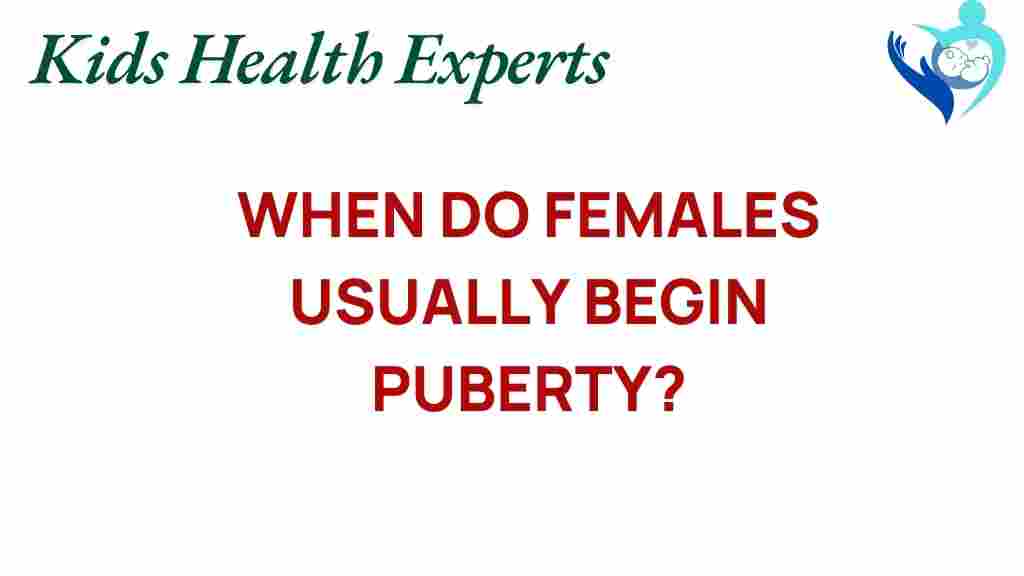Unlocking the Mystery: When Do Females Typically Begin Puberty?
Understanding the stages of puberty is essential for parents and guardians navigating the tumultuous years of adolescence. For females, puberty marks a significant transition, not just physically, but also emotionally and socially. This article delves into the timeline of female development, highlighting the early signs, physical changes, and emotional shifts that accompany this period of growth.
The Onset of Puberty in Females
Puberty generally begins between the ages of 8 and 13 for girls, although there can be considerable individual variation. Factors such as genetics, nutrition, and overall health can influence when a girl begins her growth stages.
- Average Age Range: 8 to 13 years
- Common Factors: Genetics, environment, and health
The Tanner Stages of development are often used to categorize the changes that occur during puberty. Understanding these stages helps in recognizing the physical changes that signify the beginning of this important life phase.
Hormonal Changes and Physical Development
At the onset of puberty, the body undergoes significant hormonal changes that drive physical development. The hypothalamus signals the pituitary gland to release hormones that stimulate the ovaries. This process leads to the production of estrogen and progesterone, which are critical for female development.
- **Estrogen:** Responsible for the development of breasts and the regulation of the menstrual cycle.
- **Progesterone:** Plays a key role in the menstrual cycle and pregnancy.
Early Signs of Puberty
Recognizing the early signs of puberty is crucial for parents and caregivers. Here are some common indicators:
- Breast Development: Often the first visible sign of puberty, typically starting between ages 8 and 13.
- Growth Spurts: Girls may experience significant height increases during this time, usually occurring around the age of 10 or 11.
- Menstruation: The onset of menstruation, known as menarche, typically occurs between ages 10 and 15, with an average age of around 12.
- Body Hair Growth: Increased hair growth in the armpits and pubic area is common.
- Skin Changes: Hormonal shifts can lead to increased oil production, resulting in acne.
Emotional Shifts During Adolescence
Along with physical changes, emotional shifts are a significant part of female development during puberty. Hormonal fluctuations can lead to:
- Mood Swings: Girls may experience sudden changes in mood, often influenced by hormonal changes.
- Increased Sensitivity: Emotional responses can become heightened, leading to feelings of anxiety or sadness.
- Self-Image Issues: As physical changes occur, girls may develop concerns about their appearance and body image.
Open communication about these emotional shifts is vital for healthy development. Engaging in health education can help girls understand what they’re experiencing and mitigate feelings of confusion or isolation.
The Importance of Health Education
Health education plays a critical role in preparing girls for the changes they will experience during puberty. Parents and educators should provide resources and information that cover:
- Understanding Puberty: Basic knowledge about the biological changes occurring during this time.
- Menstrual Health: Information on menstrual hygiene and what to expect during menstruation.
- Emotional Health: Strategies for coping with mood swings and emotional changes.
- Body Positivity: Encouragement to embrace body changes and develop a positive self-image.
For more resources on puberty and health education, visit this informative site.
Here’s a step-by-step guide for parents to help their daughters navigate puberty:
- Step 1: Open Dialogue – Create a safe space for your daughter to ask questions about puberty and express her feelings.
- Step 2: Provide Information – Share age-appropriate books and resources on puberty and female health.
- Step 3: Discuss Changes – Talk about the physical and emotional changes she might experience, normalizing these changes.
- Step 4: Encourage Healthy Habits – Promote good nutrition and exercise, which can help manage physical and emotional changes.
- Step 5: Be Supportive – Offer reassurance and support as she navigates this new phase of life.
Troubleshooting Common Concerns
As girls experience puberty, they may encounter various concerns. Here’s how to troubleshoot some common issues:
- Concern: Late Onset of Menstruation
- Solution: Consult a healthcare provider if menstruation hasn’t started by age 15.
- Concern: Severe Mood Swings
- Solution: Encourage open conversations and consider seeking help from a mental health professional if mood swings are disruptive.
- Concern: Acne and Skin Changes
- Solution: Establish a skincare routine and consult a dermatologist if necessary.
Conclusion
Understanding when females typically begin puberty and the accompanying hormonal changes, physical changes, and emotional shifts is crucial for navigating this important developmental stage. By fostering open communication and providing education, parents can help their daughters embrace the changes of adolescence with confidence. Ultimately, supporting young girls through puberty is not just about managing physical changes; it’s about nurturing their emotional well-being and self-acceptance during this transformative time.
For further insights on female development and puberty, you might find this external resource helpful.
This article is in the category Growth and created by KidsHealthExperts Team
